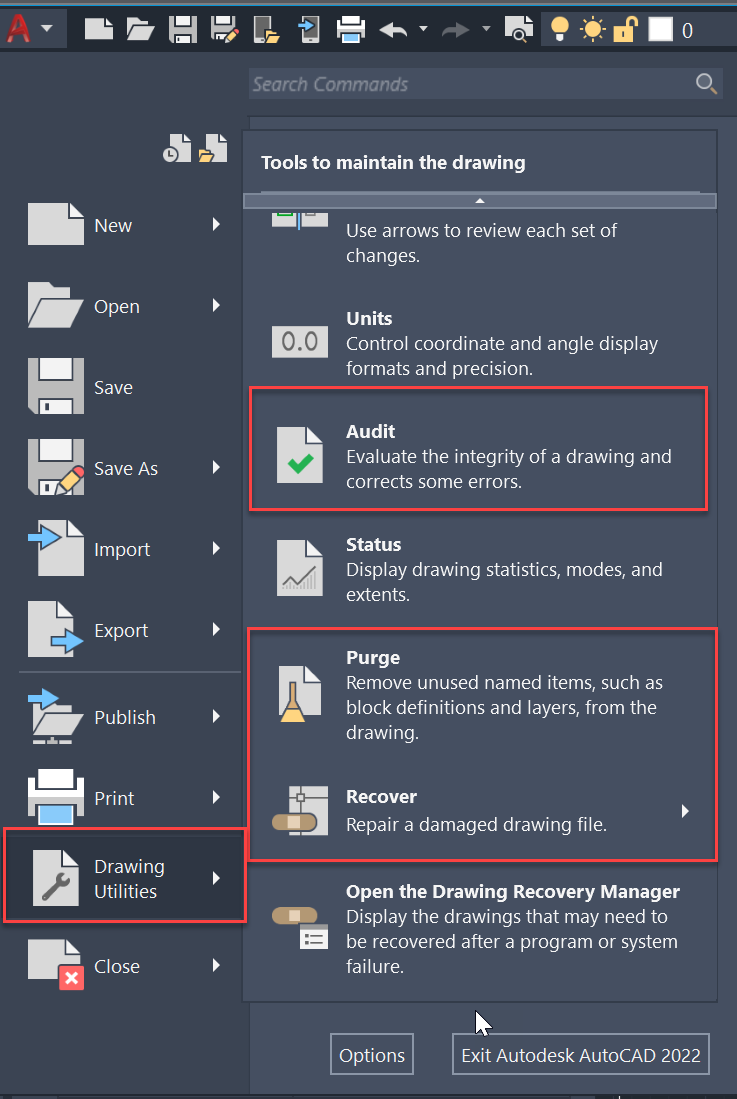Why Does Purge Draw Box
Issue:
AutoCAD or AutoCAD vertical (.DWG) file abuse tin can exist seen through one or more of the following symptoms:
- File will open with errors.
- File hangs or crashes AutoCAD.
- Slow operation when opening, editing and manipulating the file.
- Error letters when working in the file.
- Commands practise non piece of work or at that place is considerable delay in performance.
- Unexplained file size increases.
- Display/Regen problems.
- Drawing elements missing or shown incorrectly.
- Objects cannot be selected consistently.
Causes:
File corruption tin be introduced in numerous means, some examples are listed beneath:
- Third-party applications running within AutoCAD.
- DWG files created or saved by non-Autodesk or non-RealDWG products.
- AutoCAD terminated while saving the drawing.
- One-time drawings used repeatedly over long time periods.
- Network anomalies (manual errors, file locking, latent writing of data).
- Storage media degradation (bad sectors on a hard drive).
Solution:
Use the following drawing utilities to remove unused geometry and correct cartoon database errors. The commands can be found under the Awarding carte du jour › Drawing Utilities:
- AUDIT (Command) - Evaluates the integrity of a drawing and corrects some errors.
- RECOVER (Command) - Repairs and and so opens a damaged drawing file.
- PURGE (Control) - Removes unused items, such as block definitions and layers, from the drawing.
- -PURGE (Command) - Removes unused named objects, such as block definitions and layers from the drawing (available from the command line only).

The listed commands can be used individually or in combination for maintenance and fault checking. The two methods shown in the post-obit examples will perform the aforementioned tasks, although method ii which uses Recover as opposed to Audit will do a more than thorough job in detecting and fixing errors:
Method 1:
- Open the drawing file.
- Audit and fix any errors:
- Type AUDIT at the command line.
- "Y" for Yeah to fix whatsoever errors, then Enter.
- Remove unused named objects from the drawing:
- Type PURGE at the command line.
- Enable all checkboxes checked on.
- click Purge All.
- Purge Registered Applications (from the command line):
- Type -PURGE.
- "R" for Regapps (registered applications), and so Enter.
- "*" , and so press Enter (the asterisk equates to All).
- "N" when asked to verify each name to be purged, then Enter.
- Save the drawing.
Note: Step iii executes the dialog version of the Purge command, whereas step 4 uses the control line equivalent. This is because the option to purge Regapps is just available from the '-Purge' control.
Both steps three and 4 can be executed from command line. For step iii use "All" to purge all entities.
Command:-PURGE
Enter blazon of unused objects to purge [Blocks/DEtailviewstyles/Dimstyles/Groups/LAyers/LTypes/MAterials/MUltileaderstyles/Plotstyles/SHapes/textSTyles/Mlinestyles/SEctionviewstyles/Tablestyles/Visualstyles/Regapps/Nil-length geometry/Empty text objects/Orphaned data/All]: A
Enter proper noun(due south) to purge <*>:
Verify each name to be purged? [Yes/No] <Y>: N
Repeat the control:
Control:-PURGE
Enter type of unused objects to purge [Blocks/DEtailviewstyles/Dimstyles/Groups/LAyers/LTypes/MAterials/MUltileaderstyles/Plotstyles/SHapes/textSTyles/Mlinestyles/SEctionviewstyles/Tablestyles/Visualstyles/Regapps/Nix-length geometry/Empty text objects/Orphaned information/All]: R
Enter name(s) to purge <*>:
Verify each name to be purged? [Yes/No] <Y>:
Method 2:
- Close the drawing file.
- Recover and fix whatsoever errors:
- Type Recover at the control line.
- In the Select File dialog, select the problematic file.
- One time fault checking is complete the drawing will open.
Note:
- Depending on the amount of errors checked, it's good practice to use SAVEAS, renaming the drawing and keeping a copy of the original file. And so closing the file and run Recover again on the newly saved file.
- When working with a host cartoon file and information technology'south referenced files, utilise the RECOVERALL control to error cheque the references.
- Remove unused named objects from the drawing:
- Blazon PURGE at the command line.
- Enable all checkboxes checked on
- click Purge All
- Purge Registered Applications (from the control line):
- Type -PURGE
- "R" for Regapps (registered applications), then Enter
- "*" , then press Enter (the asterisk equates to All)
- "North" when asked to verify each proper name to exist purged, and so Enter
- Salve the drawing
Method 3:
For AutoCAD 2012 and subsequently versions, the PURGE and RECOVER command tin can be performed simultaneously by using the DWGCONVERT utility. This utility can also be used to batch perform these procedures on many drawings at the aforementioned time.
- To launch the DWG Convert utility, either:
- With any drawing open, enter the DWGCONVERT command.
- With no drawings open up, click on the application menu and select DWG Convert.
- In the DWG Convert window, click onConversion Setups.
- Click New and enter a name for the Conversion setup.
- Optionally, select a Conversion setup other than Standard from the drop-downward list to base of operations the new Conversion setup upon.
- In the Change Conversion Setup window, select the Check and set up errors and Purge drawings options.

- Set up other conversion options as needed.
- Click OK and soClose.
- Load files to cleanup by either:
- Clicking on theAdd together file icon and browsing to the files.
- Dragging-and-dropping the files from Windows Explorer to theFiles tree area.
- Select the newly created Conversion setup from the right-manus box.
- Click onConvert and follow additional instructions as applicable, depending on the Conversion setup settings.
Products:
AutoCAD for Mac; AutoCAD LT for Mac; AutoCAD Products;
Source: https://knowledge.autodesk.com/support/autocad/troubleshooting/caas/sfdcarticles/sfdcarticles/Optimizing-the-AutoCAD-drawing-file-Purge-Audit-Recover.html